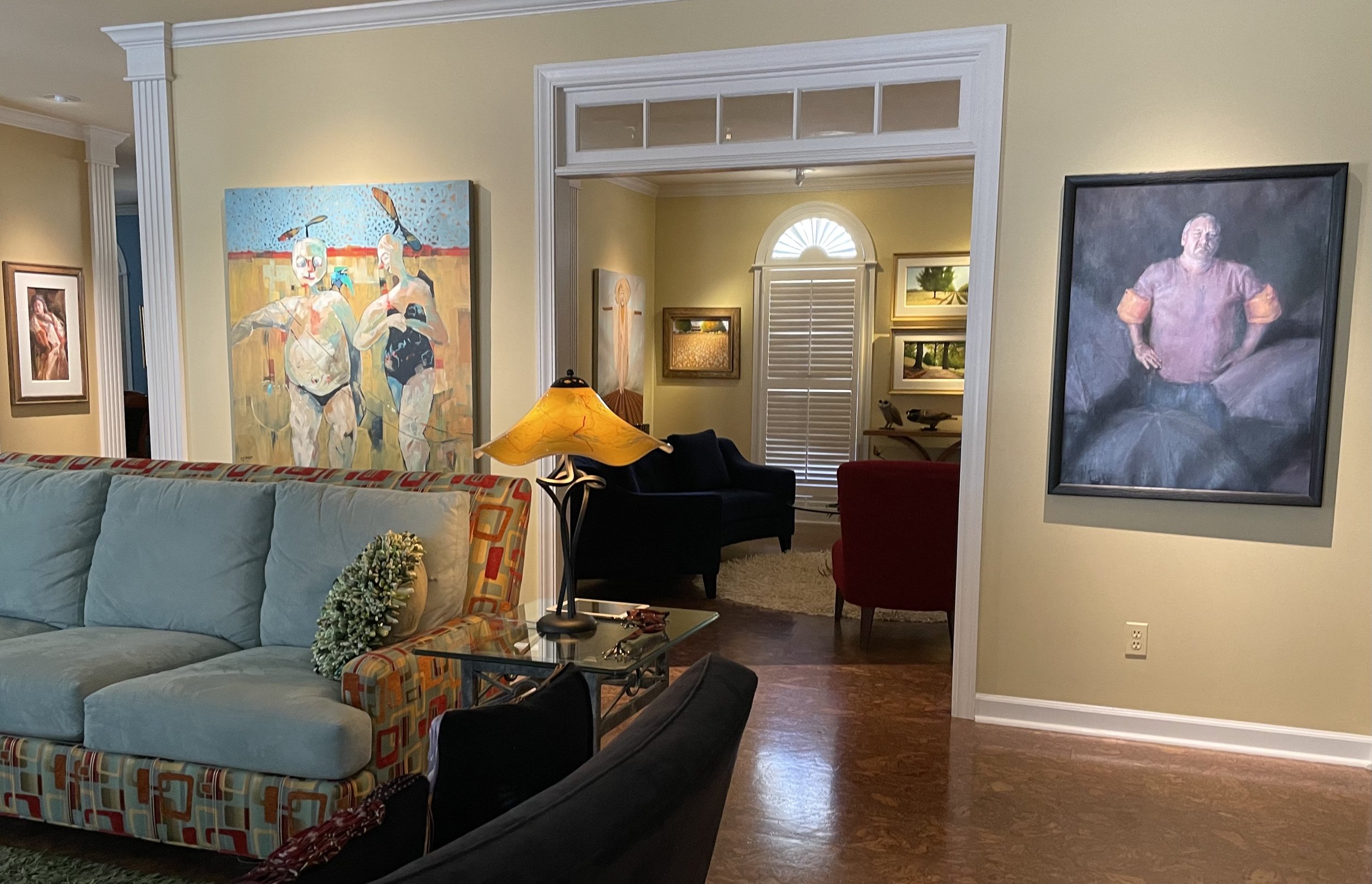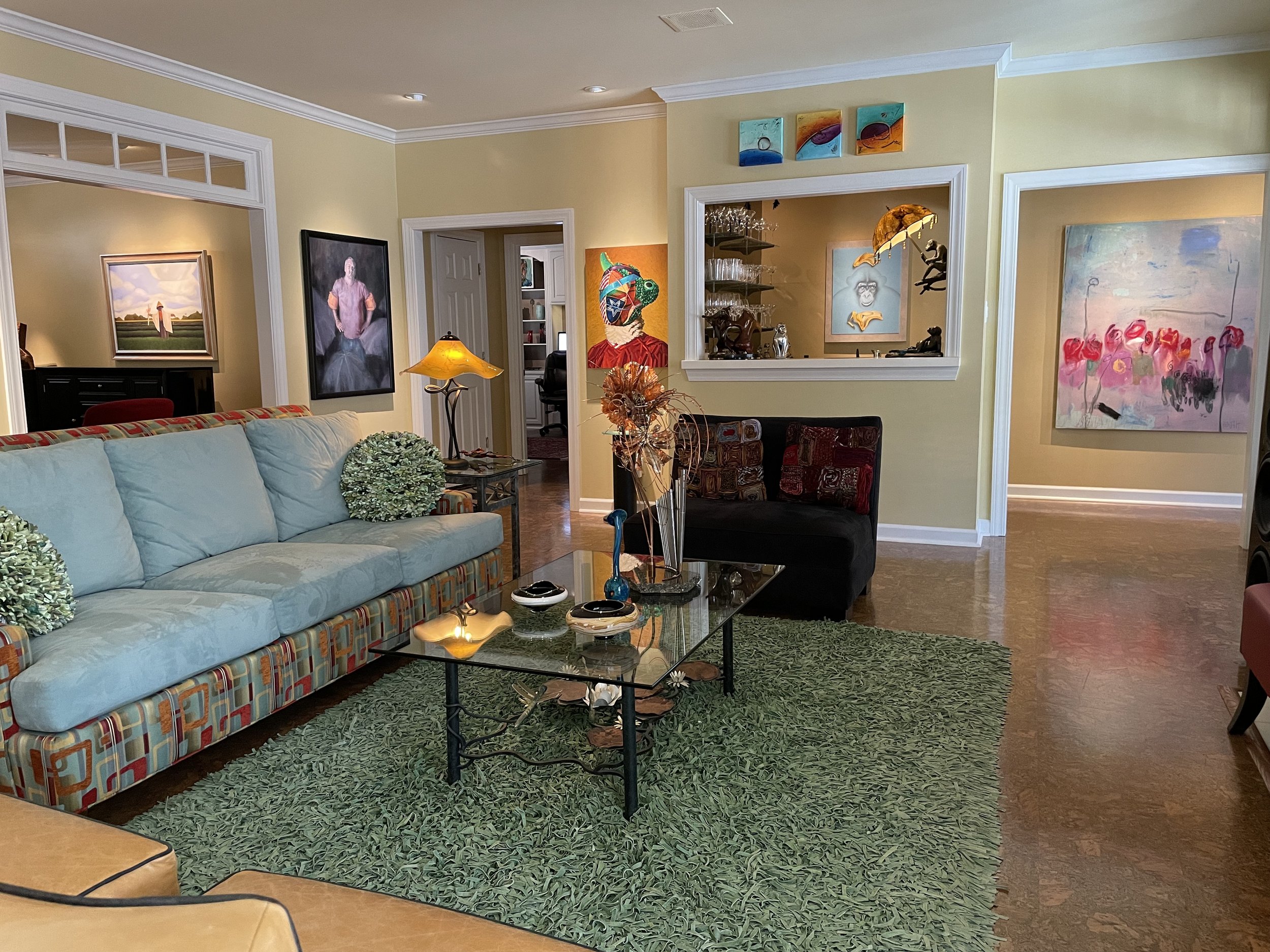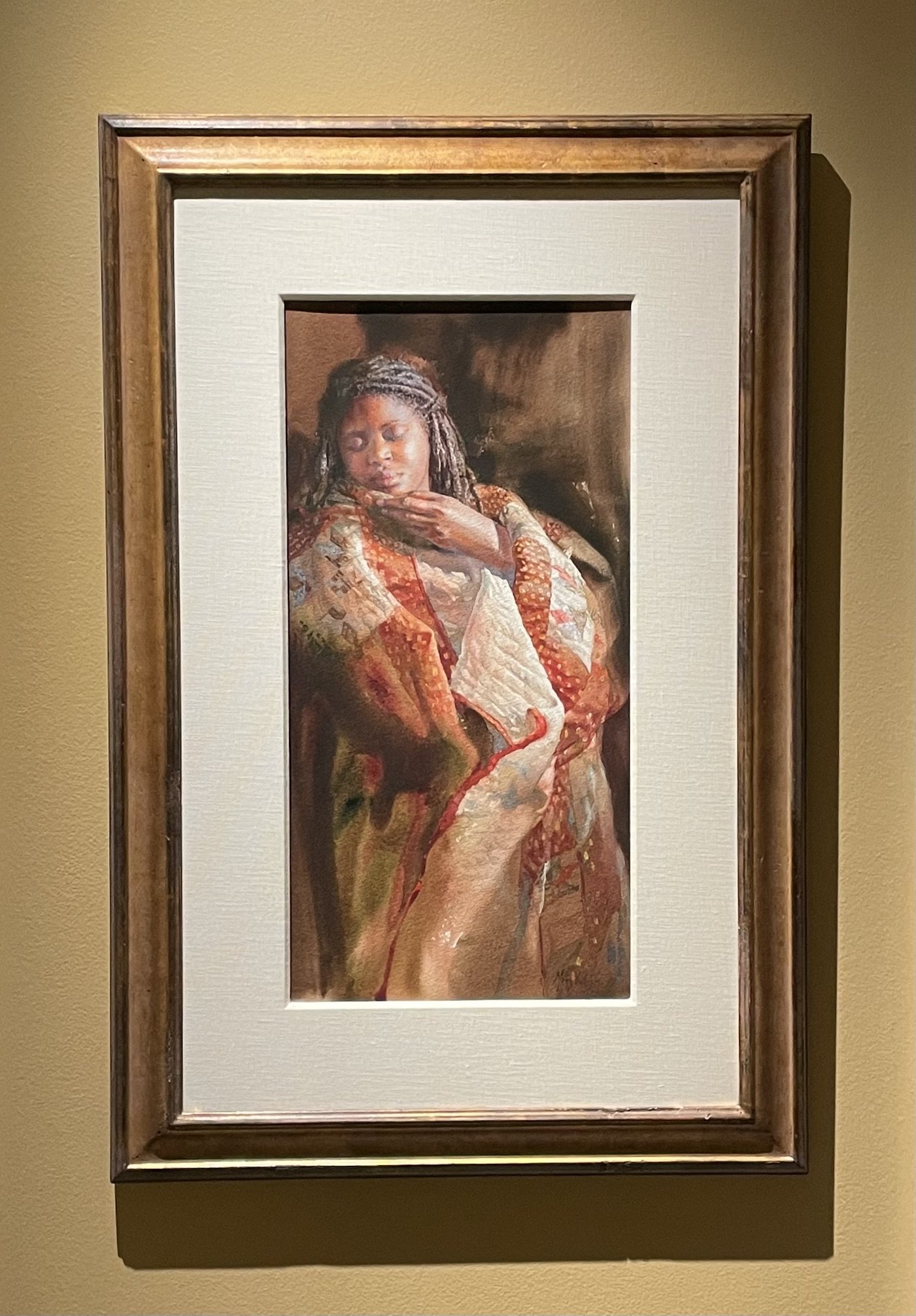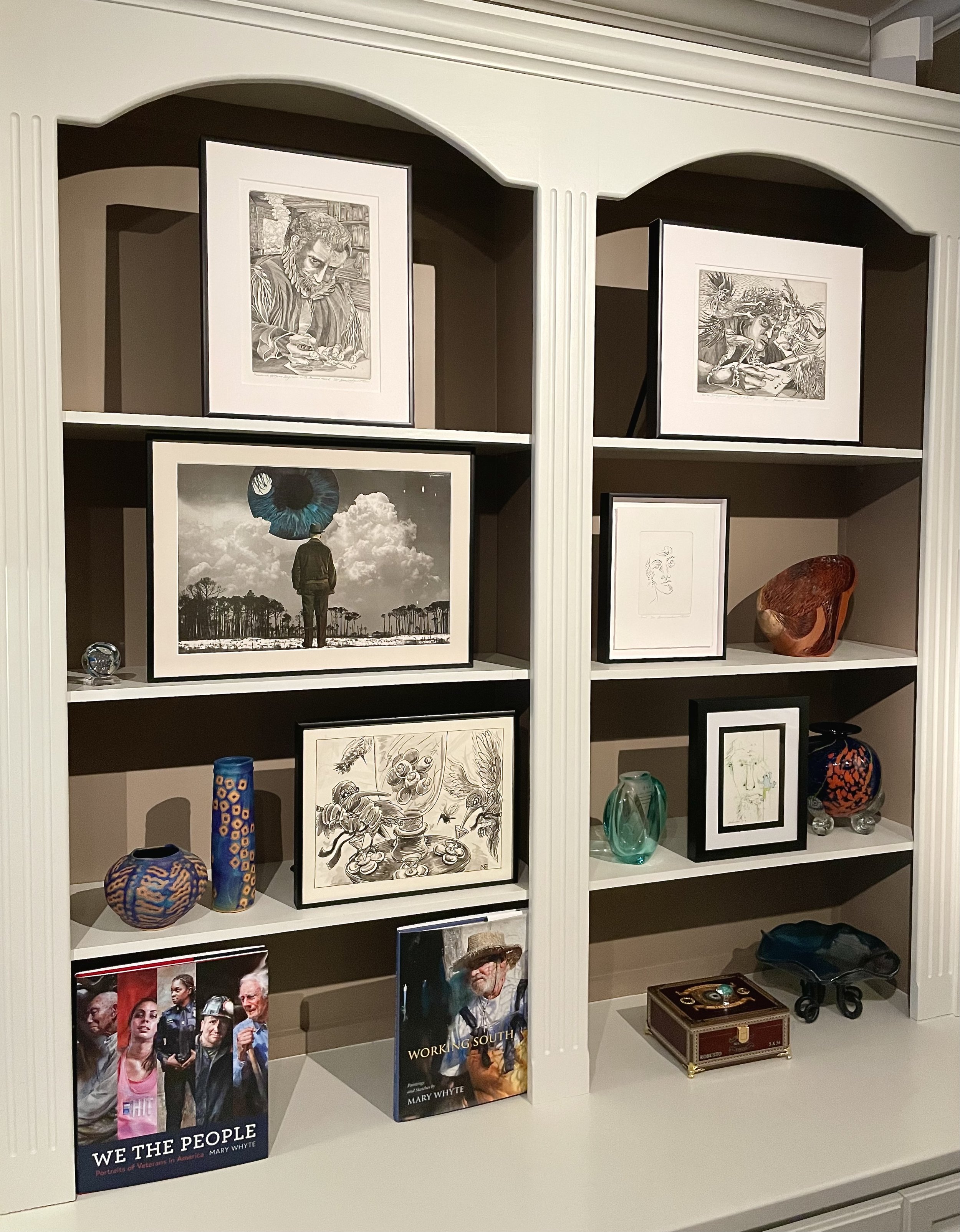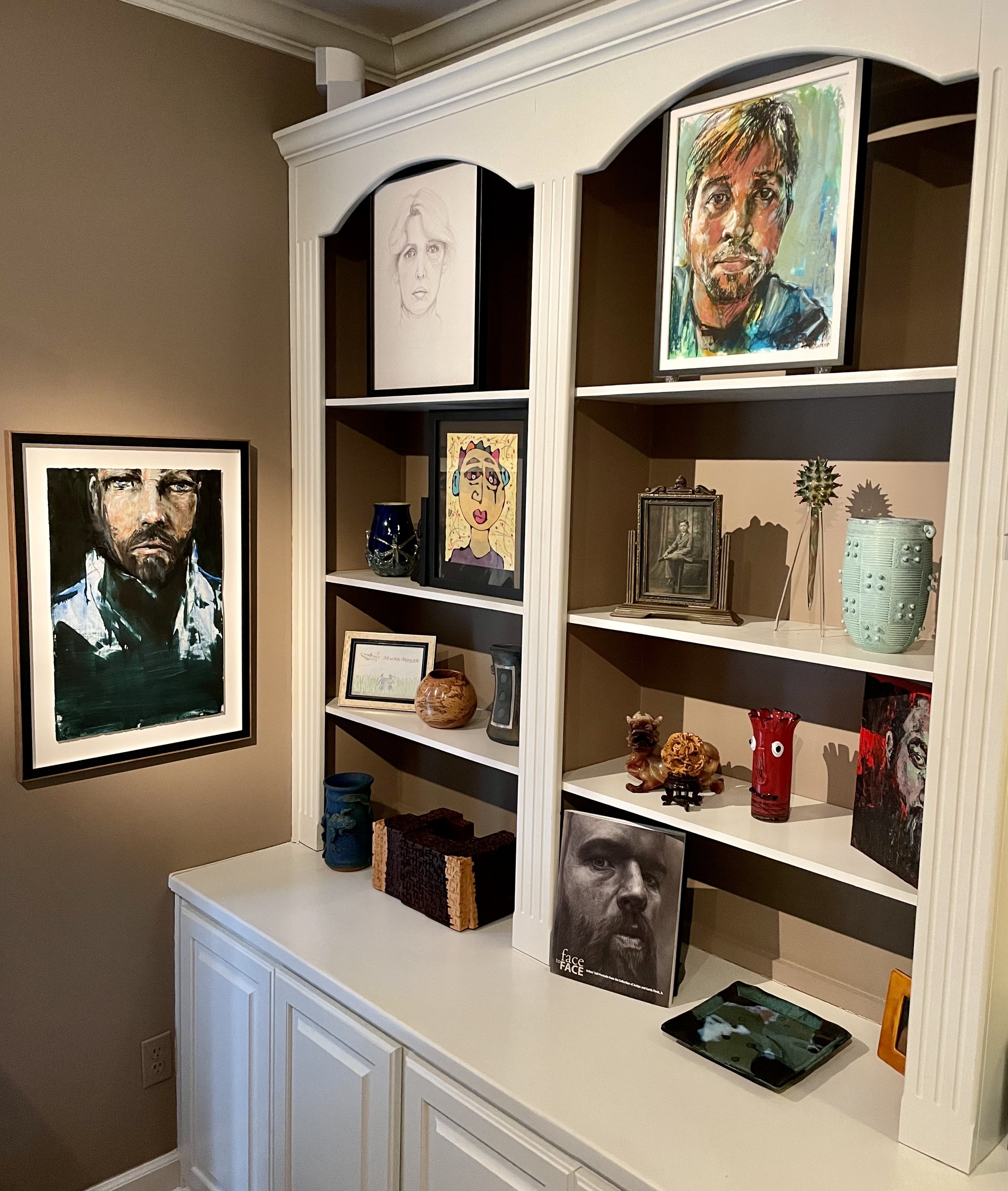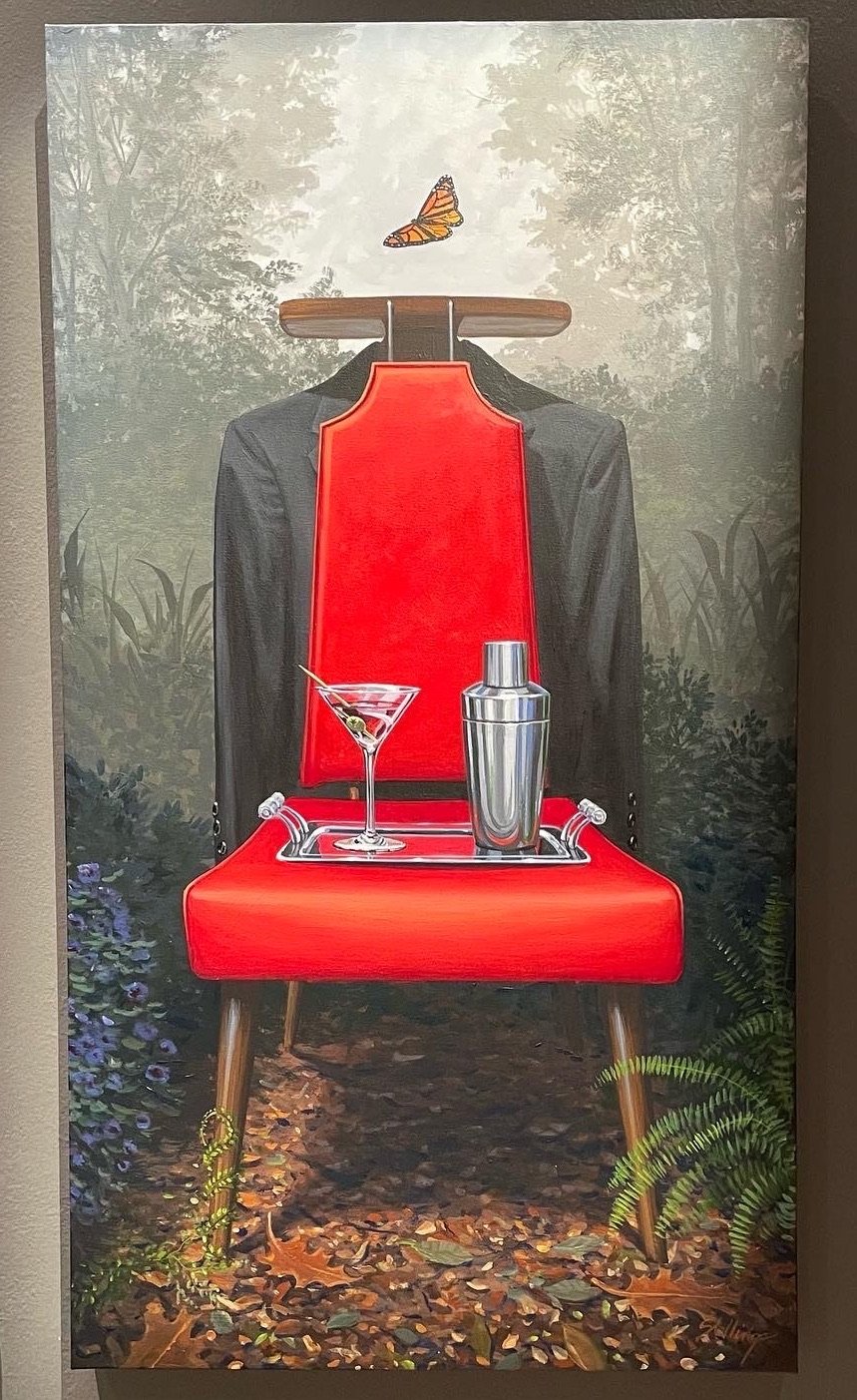Interview with collectors and AAS bloggers Philip Mayeux and Joe Nichols
For this, the 100th interview in the Arkansas Art Scene blog, I thought it would be fun to turn the tables and ask retired Democrat-Gazette Sunday Style editor and arts journalist Ellis Widner to interview me, Phil Mayeux (left) and my husband Joe Nichols as collectors and bloggers. Thanks Ellis, but damn this was hard! Now I know what those 99 artists felt like.
Cherry Platter, 23” x 27”, blown glass, Charlie Miner; Gartner/Blade glass (below the platter); Le Reve, bronze, Tim Cotterill (below center)
EW: Both of you were born in Louisiana, meeting in Little Rock 20 years ago. Were either of you already interested in art? Had you purchased any art prior to that?
Chandelier, 30” x 30”, blown glass, Ed Pennebaker
PM: I grew up in Mamou, a Cajun town of 2,000. My only exposure to art was the World Book Encyclopedia. My parents traveled a lot and often took me along, but museums were not their thing. I didn’t really see art in person until I attended Louisiana State University in Baton Rouge, where I bought my first original framed art, which we still have hanging. After LSU, I attended Tulane University in New Orleans and got the art bug there. When I moved to Little Rock in 1991 and had a real job, I started collecting Gartner/Blade glass. I have always been captivated by blown glass. Art Space at the River Market carried their work and represented a lot of wonderful Arkansas artists. I was very sad when it closed. I attended work-related meetings in Seattle and purchased some glass there and took a trip to Santa Fe, where I got to “assist” Charlie Miner blow and spin a large plate, which we have above our fireplace. That was a special experience I will never forget. Last year we added an Ed Pennebaker chandelier to our kitchen area, which we treasure.
JN: I grew up in DeRidder. I appreciated art as an observer and I had purchased a couple of prints and had a few things that I treasured, but not much more.
EW: How does your Louisiana past inform your Arkansas present?
Supper is on the Table, 18” x 24”, oil on canvas, Rebecca Thompson
JN: We both like scenes of the South. We have collected some pieces that always make me smile when I view them. A Rebecca Thompson painting, Supper is on the Table, elicited a flood of memories of my maternal grandmother the first time I saw it. Phil had the same reaction about his grandmother, so we knew instantly we had to have it.
EW: You both recently retired. What did each of you do?
PM: I always wanted to be an architect but realized I could not draw, so I went into science, Ha! In 2020 I retired (now professor emeritus) after 30 years at the University of Arkansas for Medical Sciences in the Department of Pharmacology and Toxicology. I researched kidney disease and taught graduate students and medical students.
JN: I built pipe organs for 45 years. The last 39 years I was president of Nichols & Simpson, Inc., Organbuilders. We built organs all over the Eastern half of the country. I retired in March of 2021 after completing our 76th project.
EW: Do you practice any art discipline? You both love cooking and that is very much an art!
JN: Cooking is very much my best artistic talent! I used to say, with a laugh, that I couldn’t draw a straight line with a ruler. I think I have a talent for lighting art so that all of the best attributes of each piece are uniquely addressed. We only buy art because we want to look at it, therefore lighting is especially important to us. After we bought this house, I added some 25 new recessed lighting fixtures. Now all the art is lit with museum-quality LED bulbs, which do not emit harmful UV light, selected for color accuracy and the ideal beam angle to bring out the best in each piece of art.
PM: I have no artistic talent to create fine art. When I moved to Little Rock, I joined the (then) Arkansas Arts Center and took classes at the Museum School, two in pottery and one in watercolor. It was lots of fun, but it only confirmed what I suspected about my abilities. Still, I met some wonderful people and Joe and I became members of the A/MFA Collectors Group and Contemporaries. We hosted the Contemporaries in 2017 to view our collection. Being members of the A/MFA and learning from other like-minded art lovers has really enriched our lives – and our circle of friends.
Summer Flowers, 54” x 54”, acrylic on canvas, Jan Gartrell
EW: You and Joe were together about two years before you bought your first piece of Arkansas art: Jan Gartrell’s Summer Flowers. Describe it and why it appealed to you.
Gather Ye Rosebuds, 56” x 48”, acrylic on canvas, Jane Booth
PM: We wanted some art for our first house in 2003 and started going around to galleries. We heard about The Showroom, in Little Rock, owned by Sandy Hubler, that carried some large (for us) wrapped canvas art. That is where we saw Jan Gartrell’s Summer Flowers. We fell in love with it immediately. Just one of those times. I think for both of us it was the color and its impressive size and that it has a strong abstract feel. That trip also introduced us to Sandy’s work, and we eventually acquired several of her paintings. We like large scale works. Two more of our favorite large abstract impressionist works are Gather Ye Rosebuds by Kansas City’s Jane Booth and Spirit 1 by Arkansas native James Powell Hendricks.
Spirit 1, 40” x 92”, acrylic on canvas, James Powell Hendricks
EW: Arkansas art dominates your collection, particularly the works of Sheila Cotton. You have said Beware is especially meaningful to you. Why?
JN: Beware represents a defining point in the direction of our art collecting. Prior to acquiring this painting, we had focused on contemporary abstract art. Melissa Morgan at Tobi Fairley’s gallery showed us this painting one afternoon in 2008 when we stopped by the gallery to look at some abstract works for our new house. We both looked at each other and instantly knew there was something magical and special happening on that canvas and that we had to have it. I had just completed a new pipe organ in Naples, Florida., and, by coincidence, Sheila, who is originally from North Little Rock, was living in Naples at that time. When Melissa told her we were coming to Naples for the dedication of the organ, Sheila kindly offered to take us to lunch. We had a lovely visit and she even came to the organ dedication concert.
Beware, 30” x 40”, oil on canvas, Sheila Cotton
EW: Sheila Cotton has more works in your collection (24) than any other artist. What is so appealing to you about her work? You three are also close friends. How has that friendship enriched and changed you and your perspective on her art and art in general?
JN: Our purchase of Beware was quickly followed by more Cottons, including a couple of commissions. Many of her paintings utilize magic realism. It is an appealing style to us and makes her paintings so instantly identifiable. Shelia relocated to Little Rock and our friendship blossomed as did our collection of Cottons. An interesting note is that Curtis Finch transported Beware to Little Rock for Sheila. We did not know Curtis and his wife Jackye—yet. Through Sheila, we have all become close friends. Our circles of friends have since intertwined and we are all much richer for our shared experiences and our love of art. We have celebrated Thanksgiving with this blended group for many years as well as birthdays, special occasions and just because.
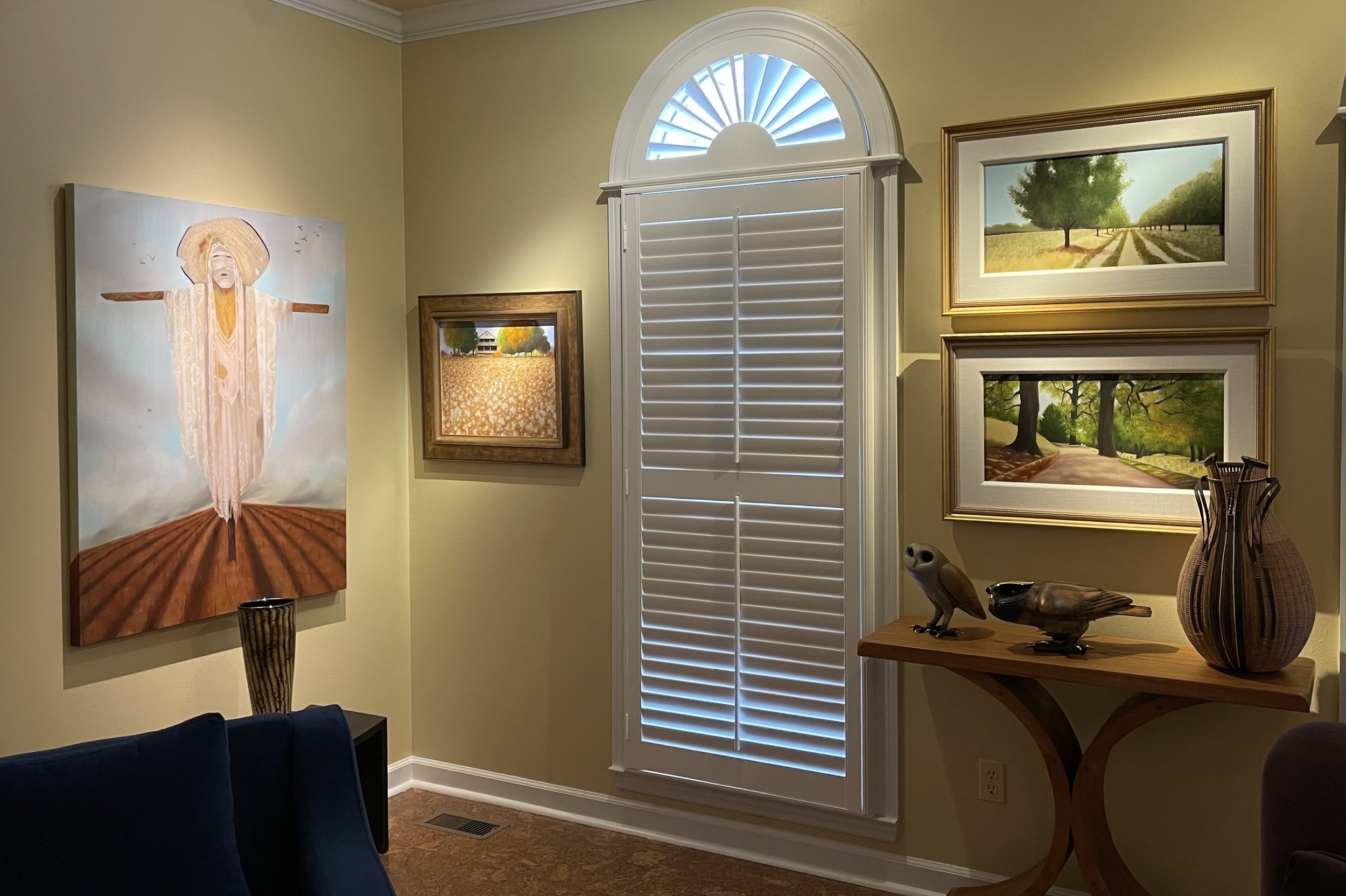
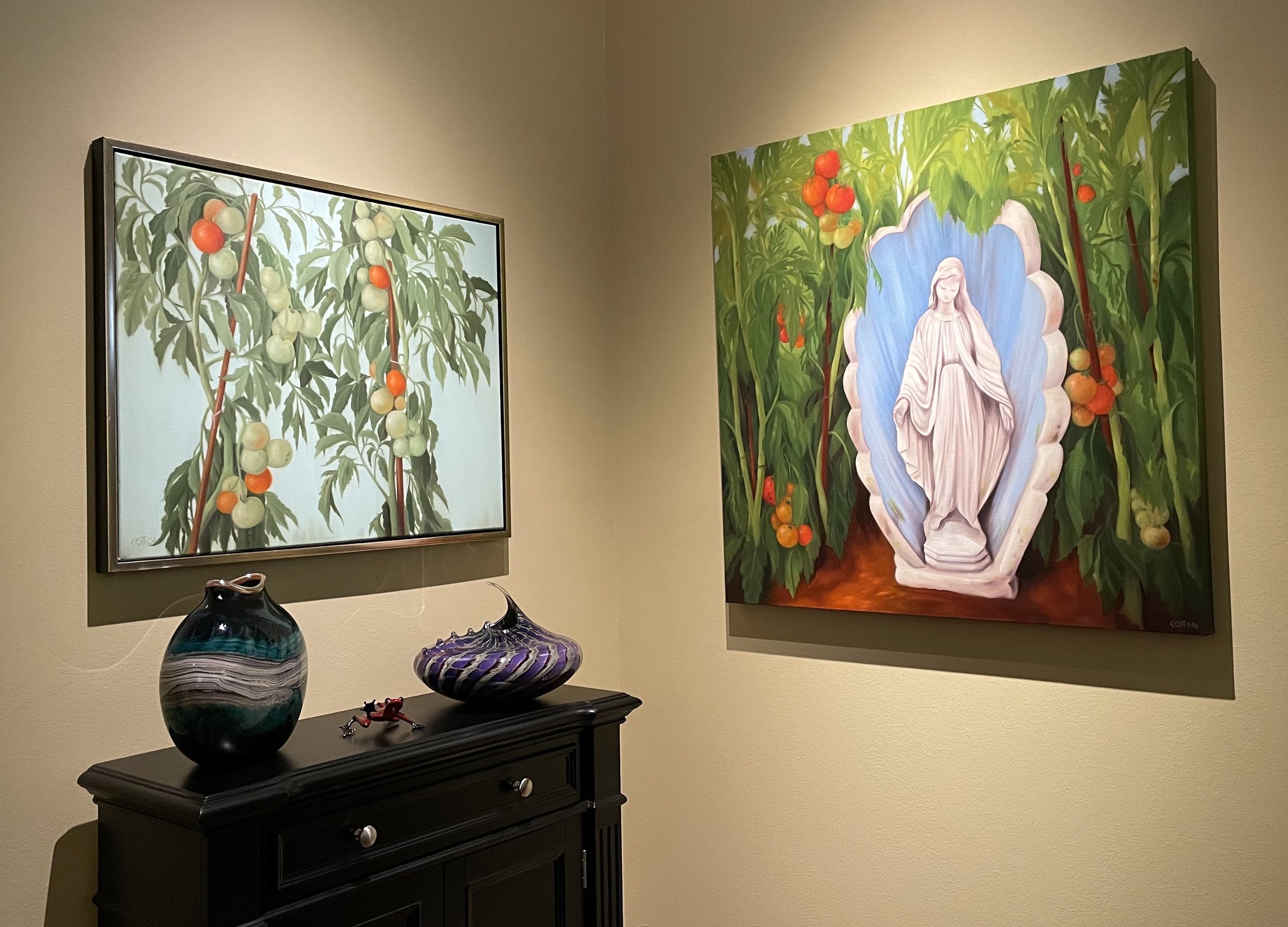
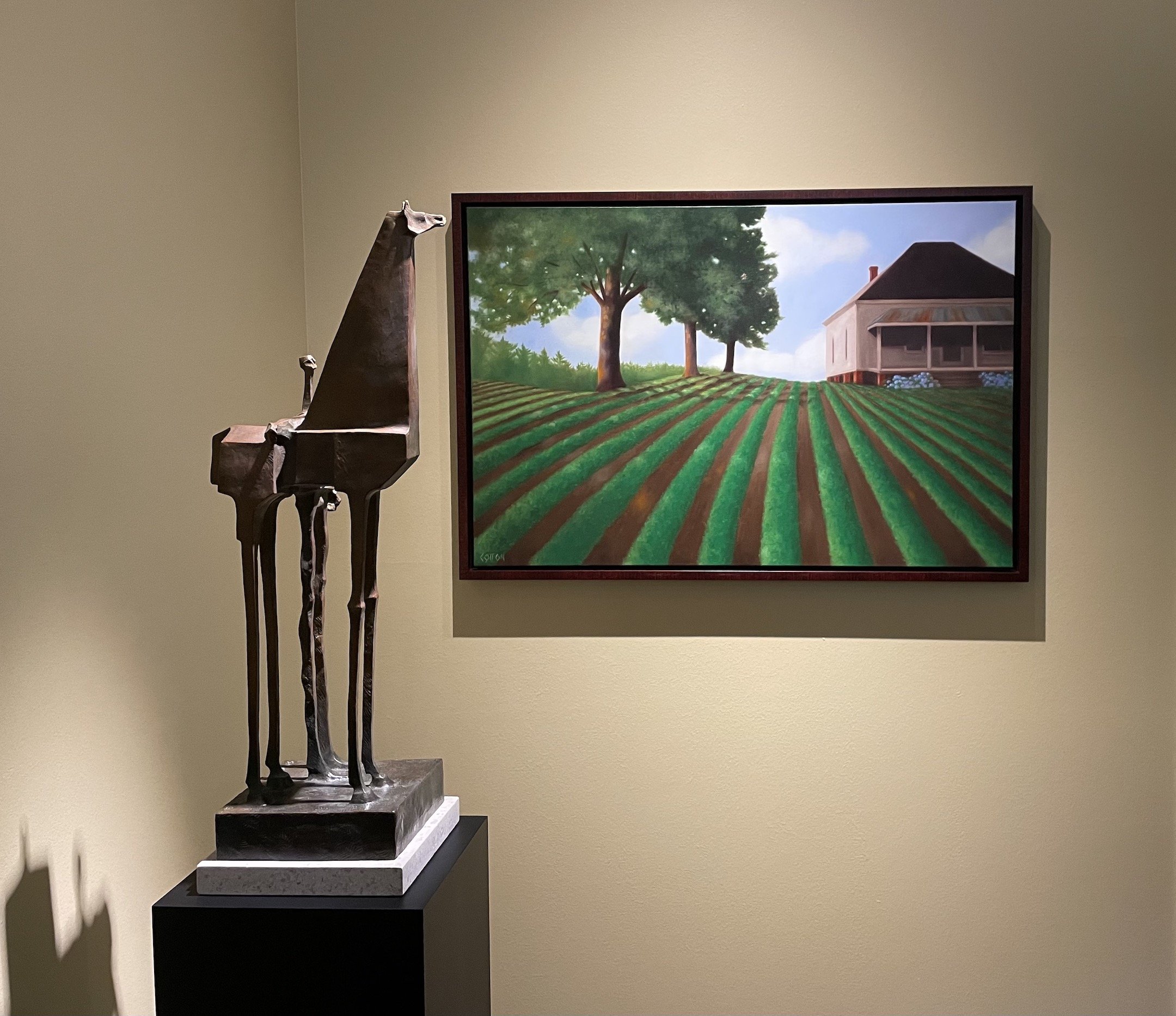


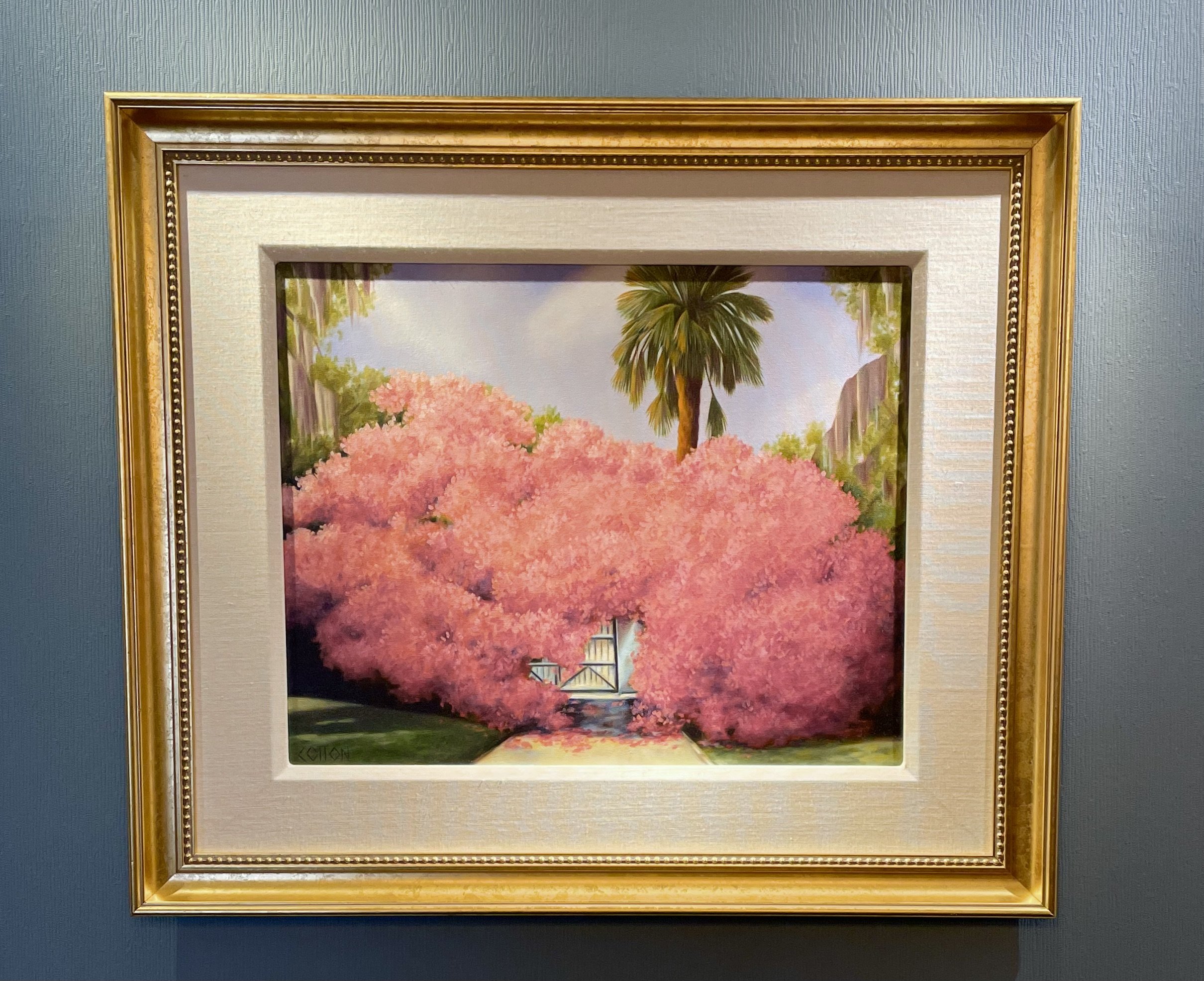

EW: Phil, I love the story of you commissioning a work of art to celebrate Joe’s career in pipe organs. Why did you pick the late Todd Crockett?
Splendid, 36” x 48”, acrylic on canvas, by Todd Crockett
PM: That was in 2005. I did not know Todd particularly well, but we had friends who had his spectacularly colorful abstracts and I had seen the painting he did of Bill Clinton. We were very much into abstract paintings then and I thought why not ask Todd if he would interpret one of Joe’s pipe organs. I took Joe’s portfolio to Todd and all I really said was that I liked greens and blues. The rest I left up to him. A few days later he asked if I would get him a CD of a concert played on one of the organs, so I sent him a couple. Todd later told me he listened to the organ music while he painted. He chose to incorporate case work and the names of the churches from several of the organs. The result he titled Splendid could not have been more perfect nor more “Todd.” Todd passed away in 2008, but his legacy and talent lives on, captured in his beautiful work.
Avalon, 24” x 18”, acrylic on canvas, Robin Tucker
EW: You also have a number of works by Robin Tucker and Kendall Stallings. What draws you back to their work again and again?
PM/JN: We feel that Robin Tucker is super talented, not just for his paintings, but also his spectacular murals! The first time we saw his work was at the Butler Center (now Galleries at Library Square) in Little Rock. We purchased our first piece, Avalon, there. We next saw his work at M2 Gallery at their original location in West Little Rock and over time purchased five other pieces including Gone, our home bar mascot. His work is so detailed, original, and FUN!
We first saw Kendall Stallings’ work at Greg Thompson Fine Art in North Little Rock and were mesmerized. Kendall now lives in Dallas. His work is mysterious, sensuous, and luscious. We own eight of his paintings, two of which are commissions. The paintings in our master bath are all by Stallings.
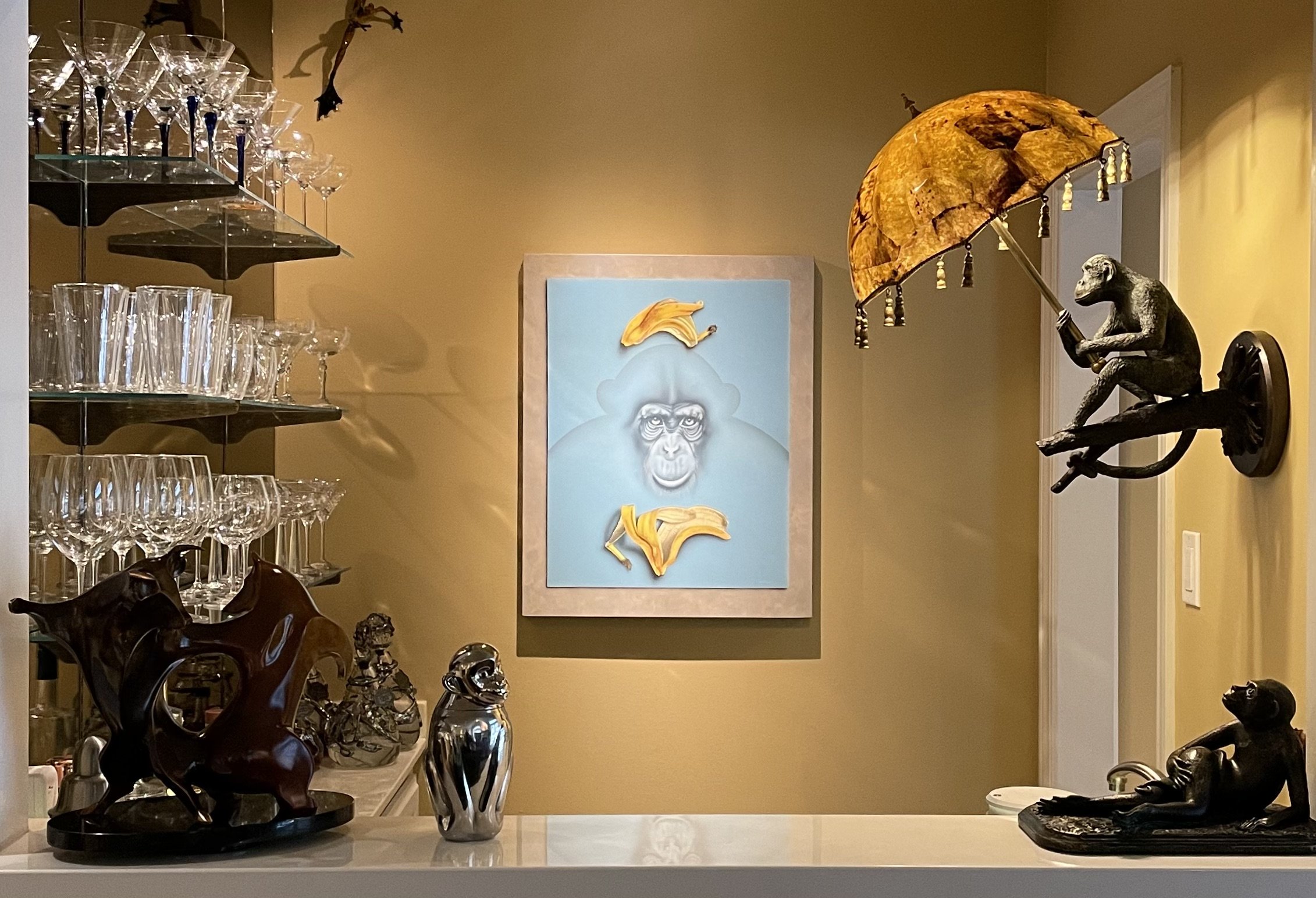

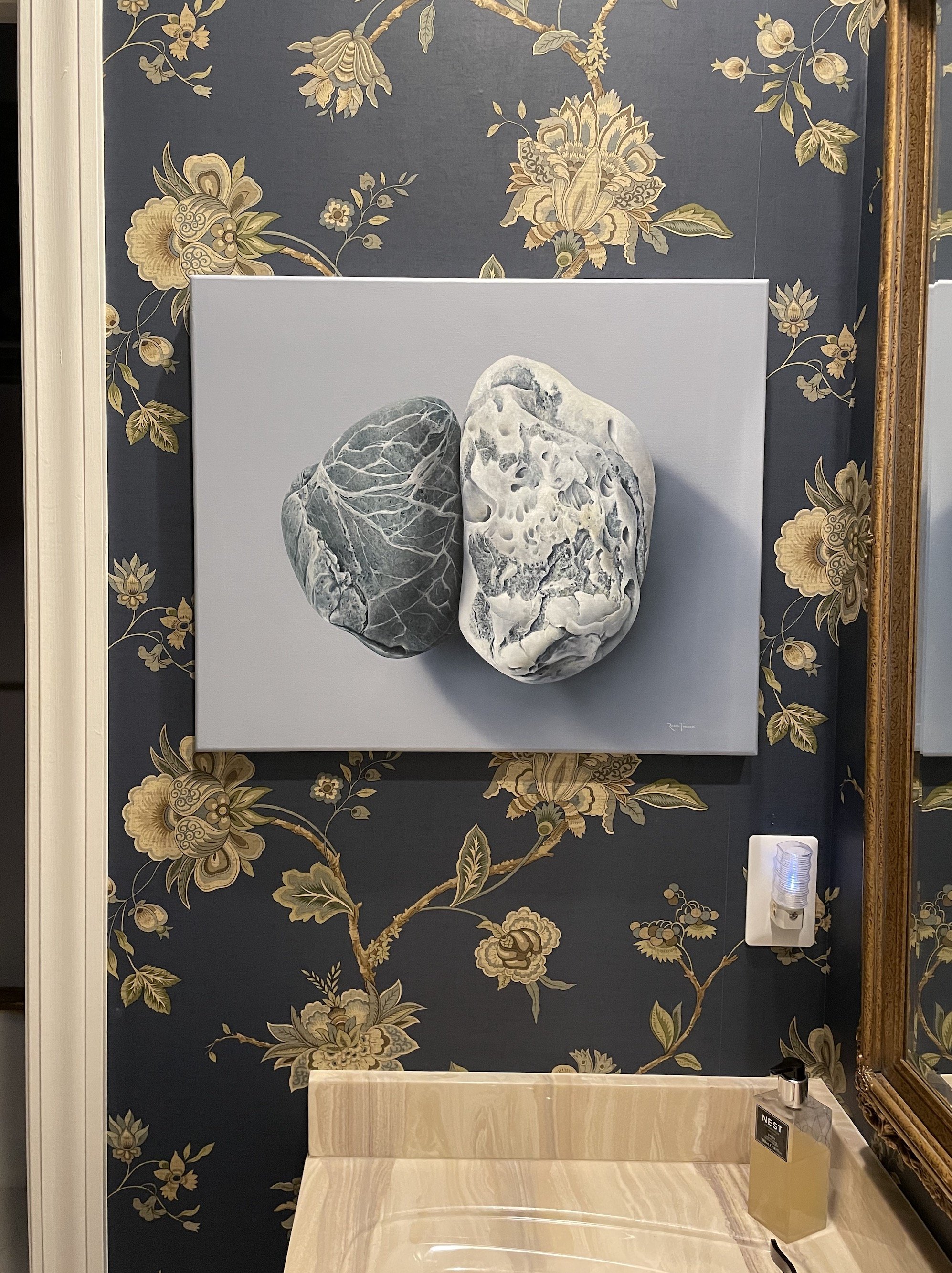

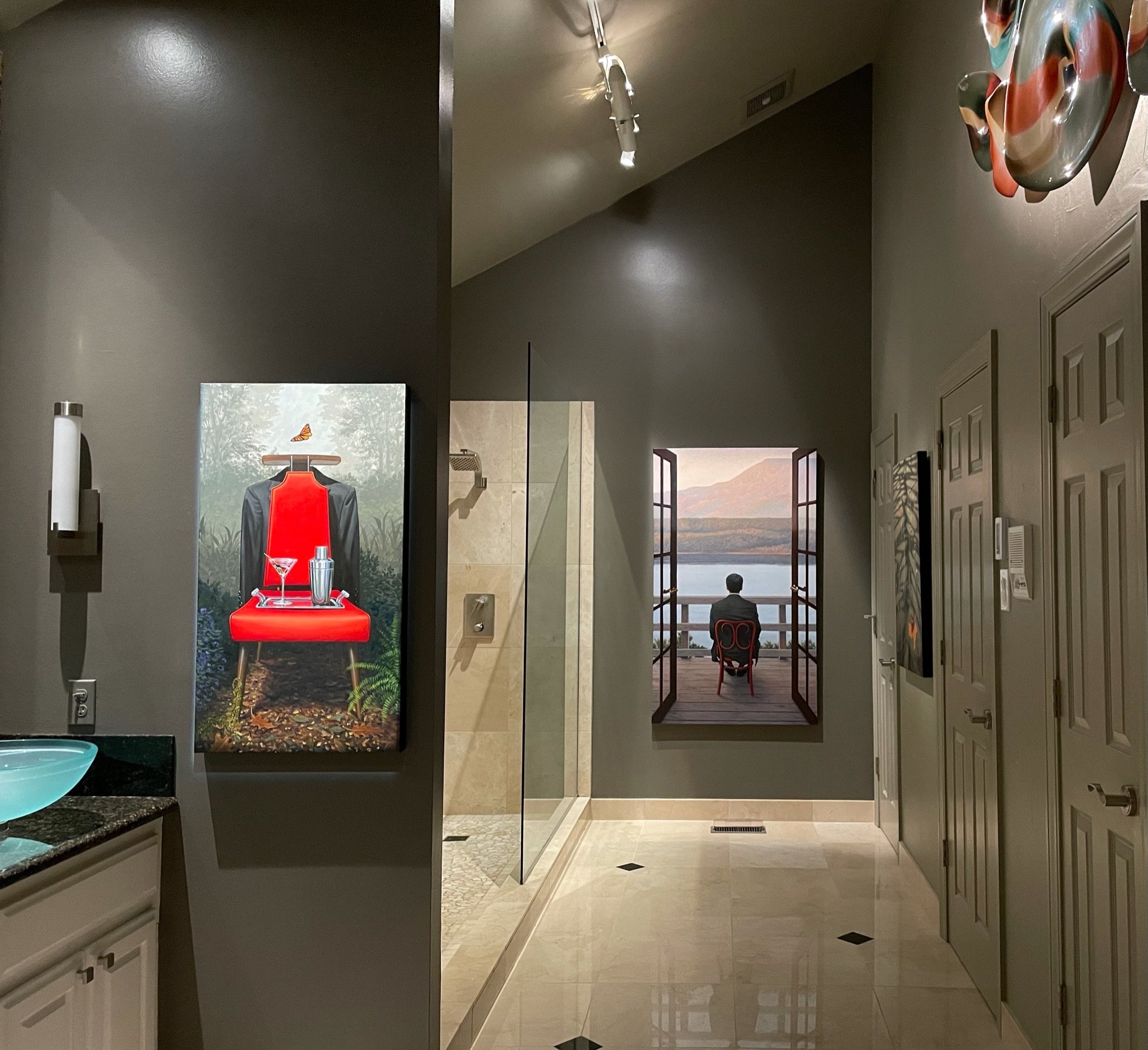
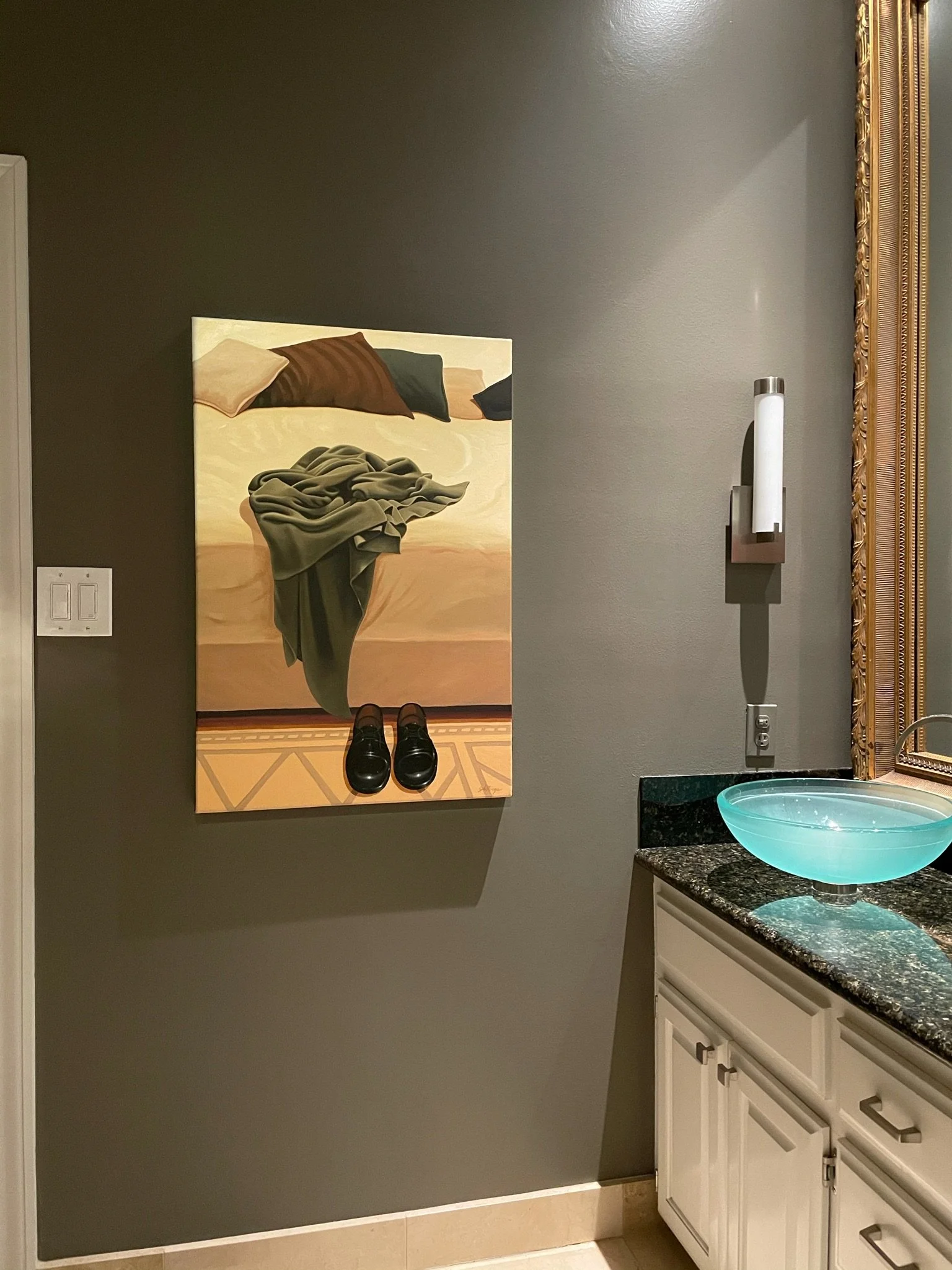


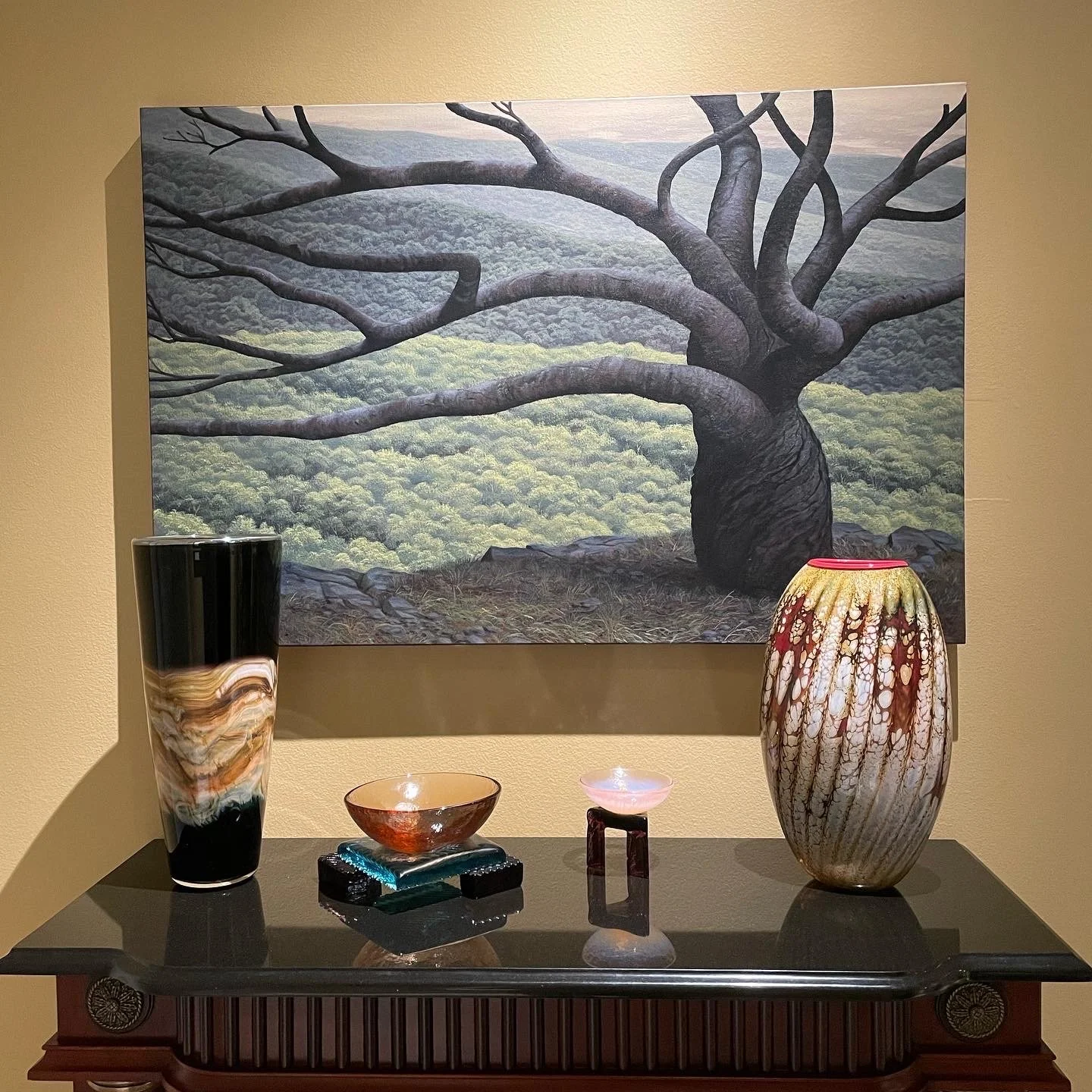
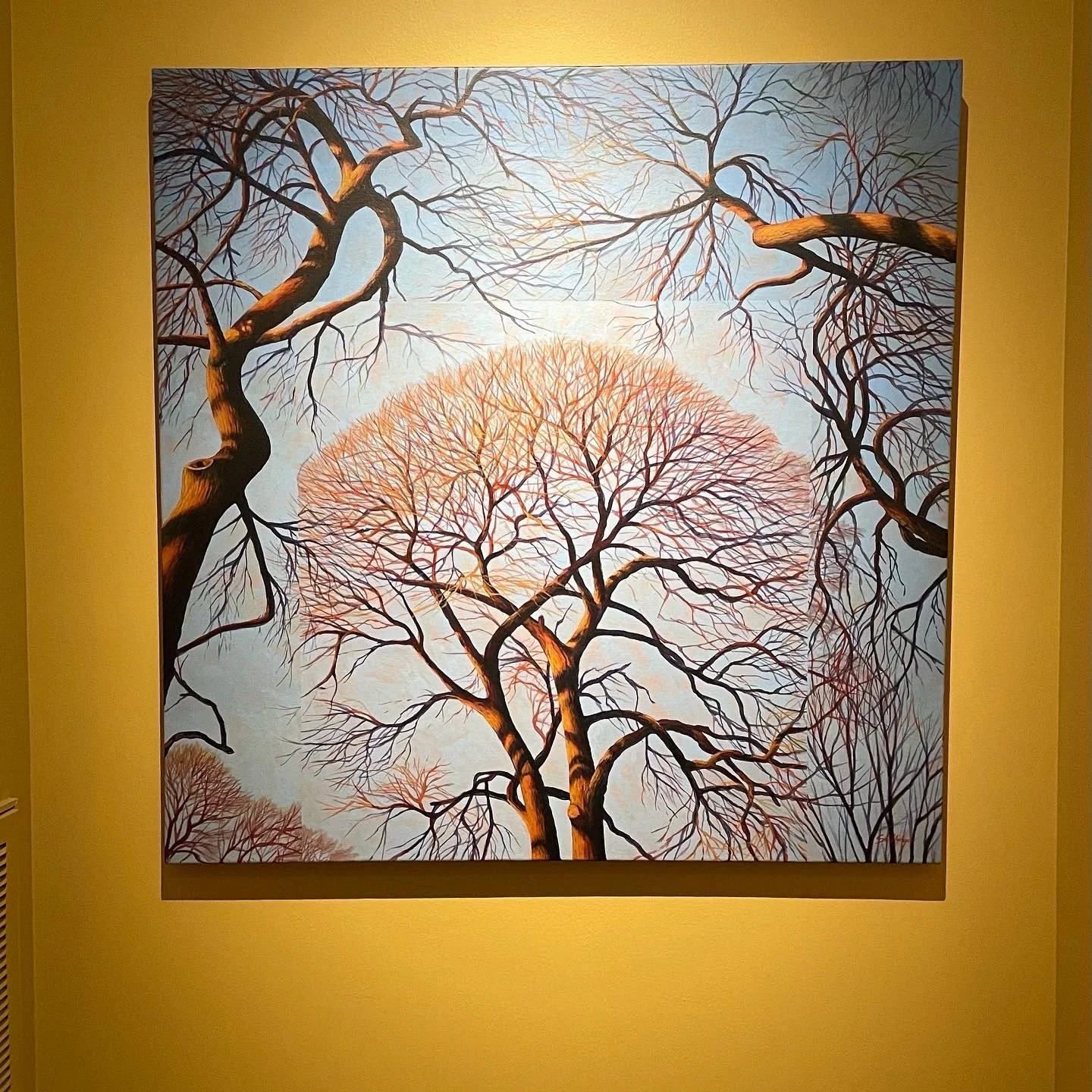
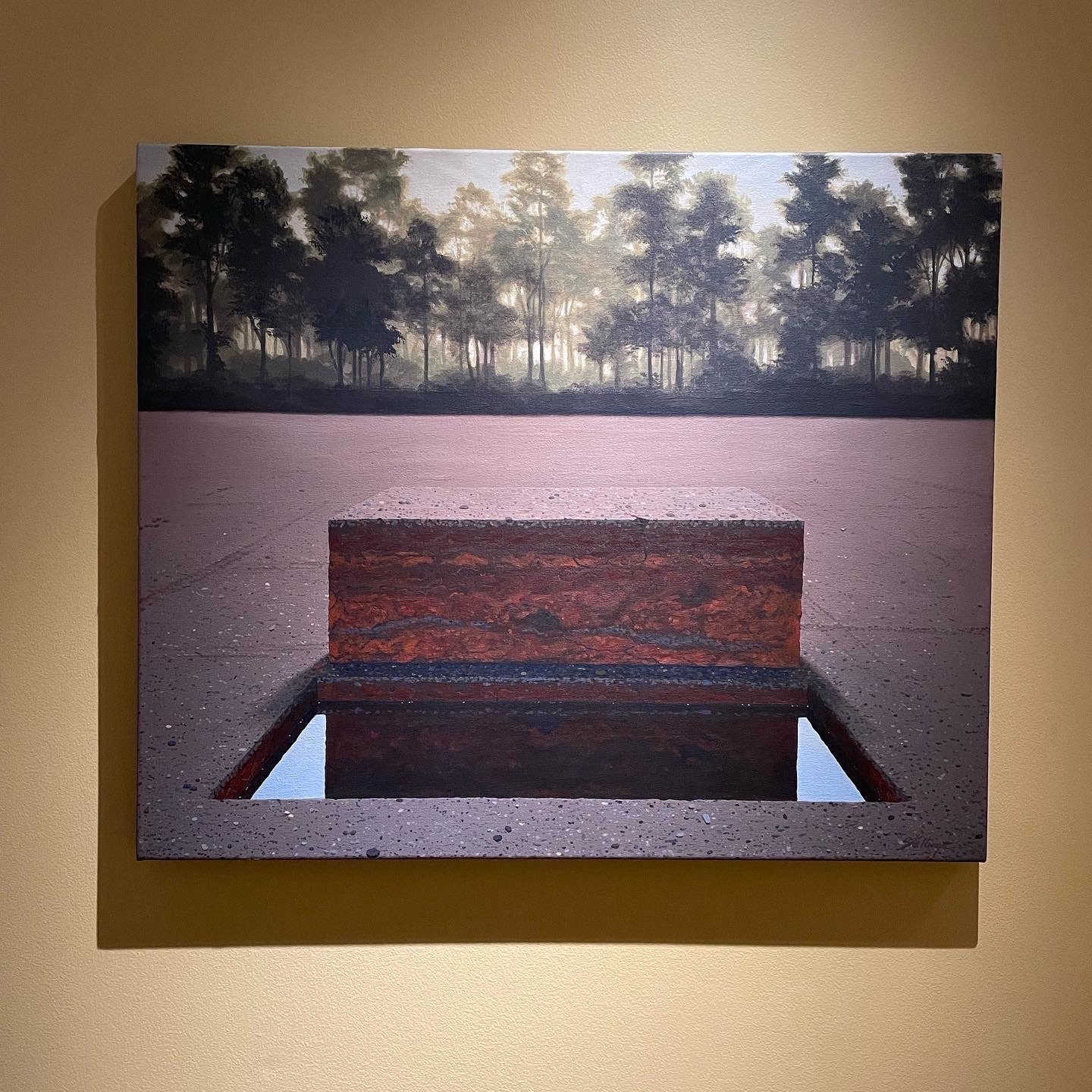
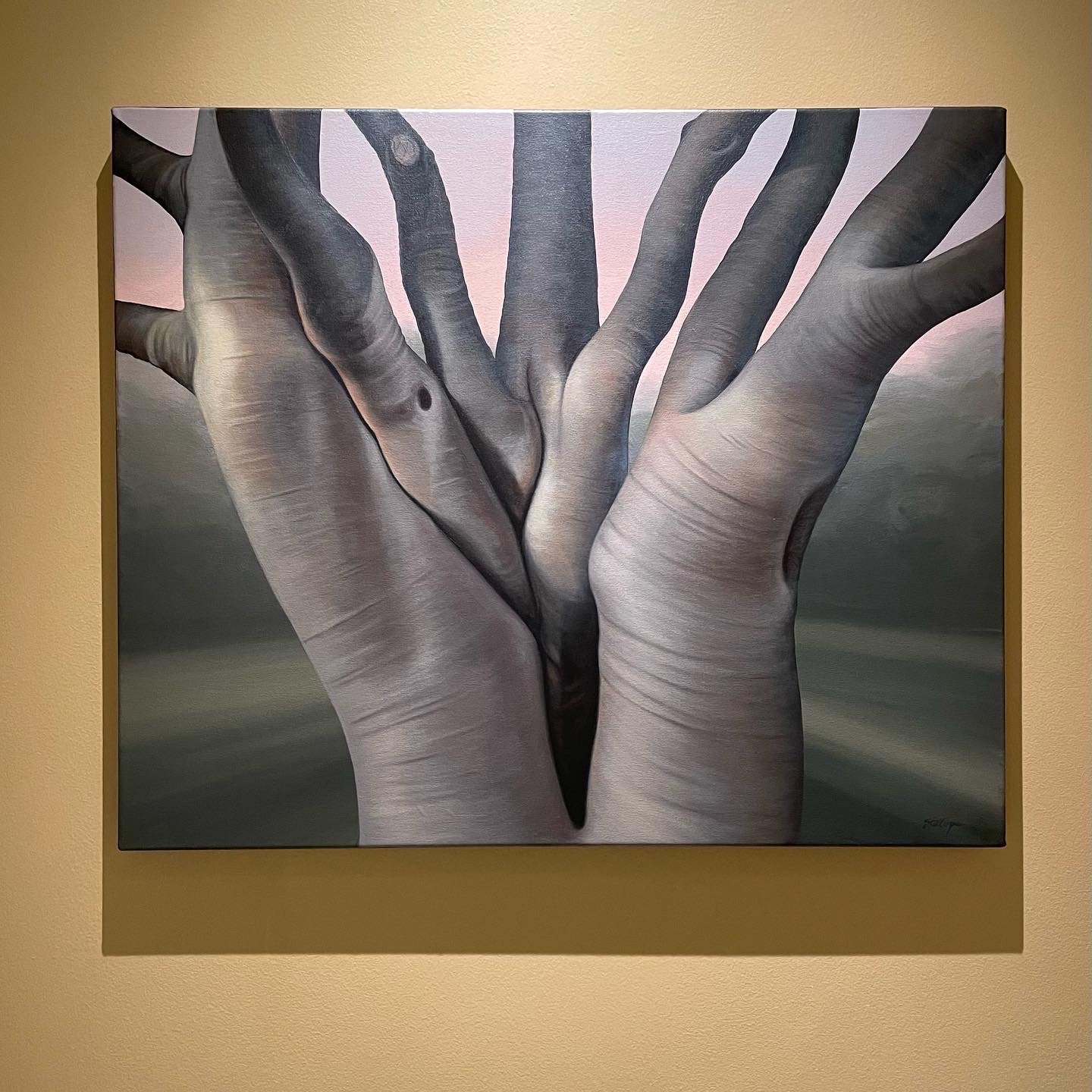
EW: How do you and Joe decide what to buy? What goes on in your heads as you examine, study, respond to a work?
“We are not ‘investment’ collectors, nor do we collect just to have a more complete representation of Arkansas artists. It is all about the feeling we get when we look at the piece.”
PM: We have the one rule, that Joe mentioned before: we buy it because we like it and want to see it. We are hesitant to acquire any new piece that would require placing something else we love in a closet. I think right now there are 3 or 4 paintings in the closet and one of those was a “day drinking” buy in Key West, if you know what I mean. It was the only bad choice we ever made.
Right now, we are almost exclusively buying art from Arkansas artists – but not just to have more. The piece, 2D or 3D, must make us feel that it belongs in our home. We are not ‘investment collectors’, nor do we collect just to have a more complete representation of Arkansas artists. It is all about the feeling we get when we look at the piece.
JN: A few times Phil has shown me a piece that he liked and then we went to see it in person, but most often we find the pieces together. There is rarely an extended discussion. We are so on the same page it reminds me of the subtle bidding motions made at an auction. A head nod here, a subtle hand motion there is often all the discussion that takes place.
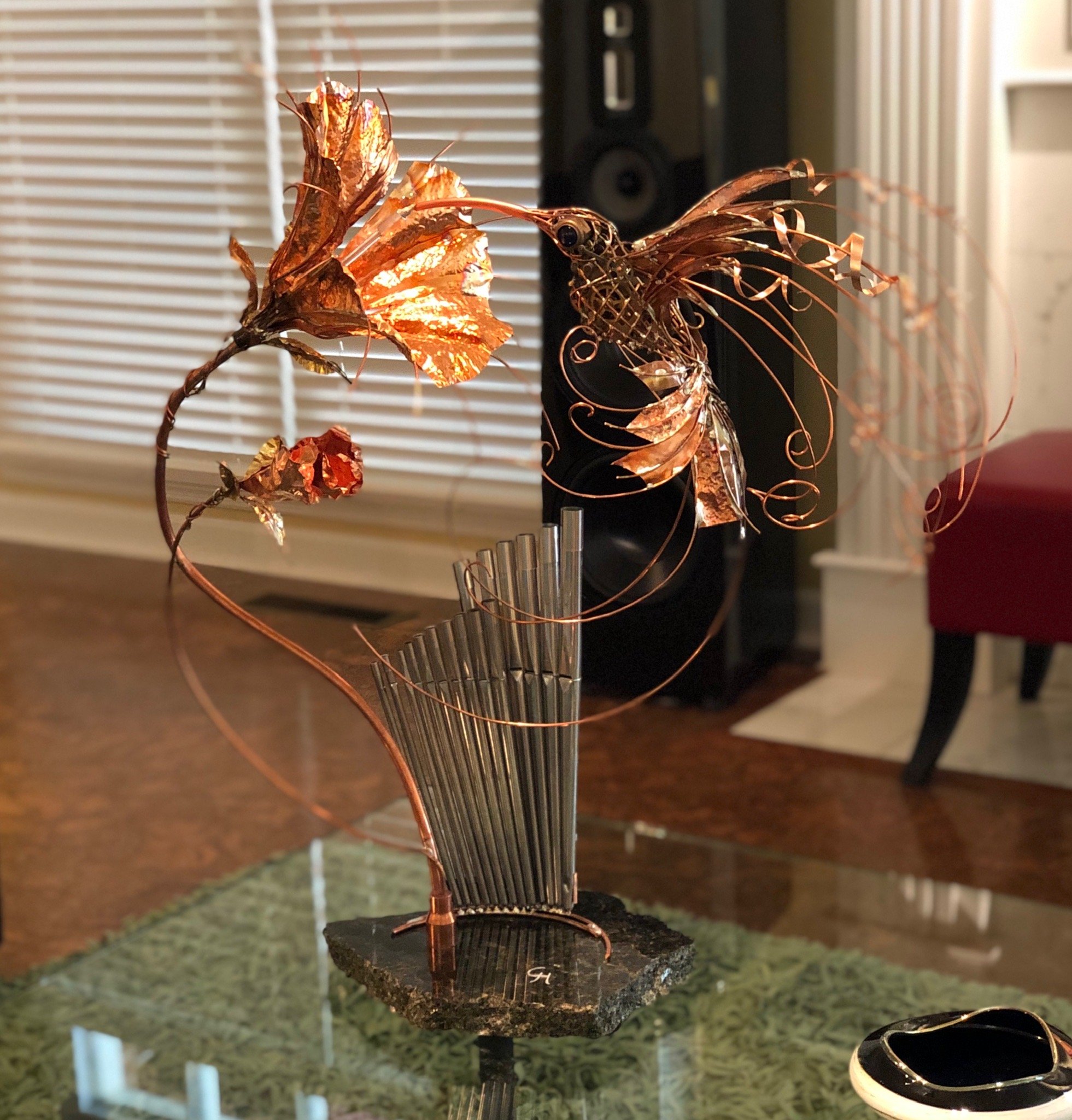
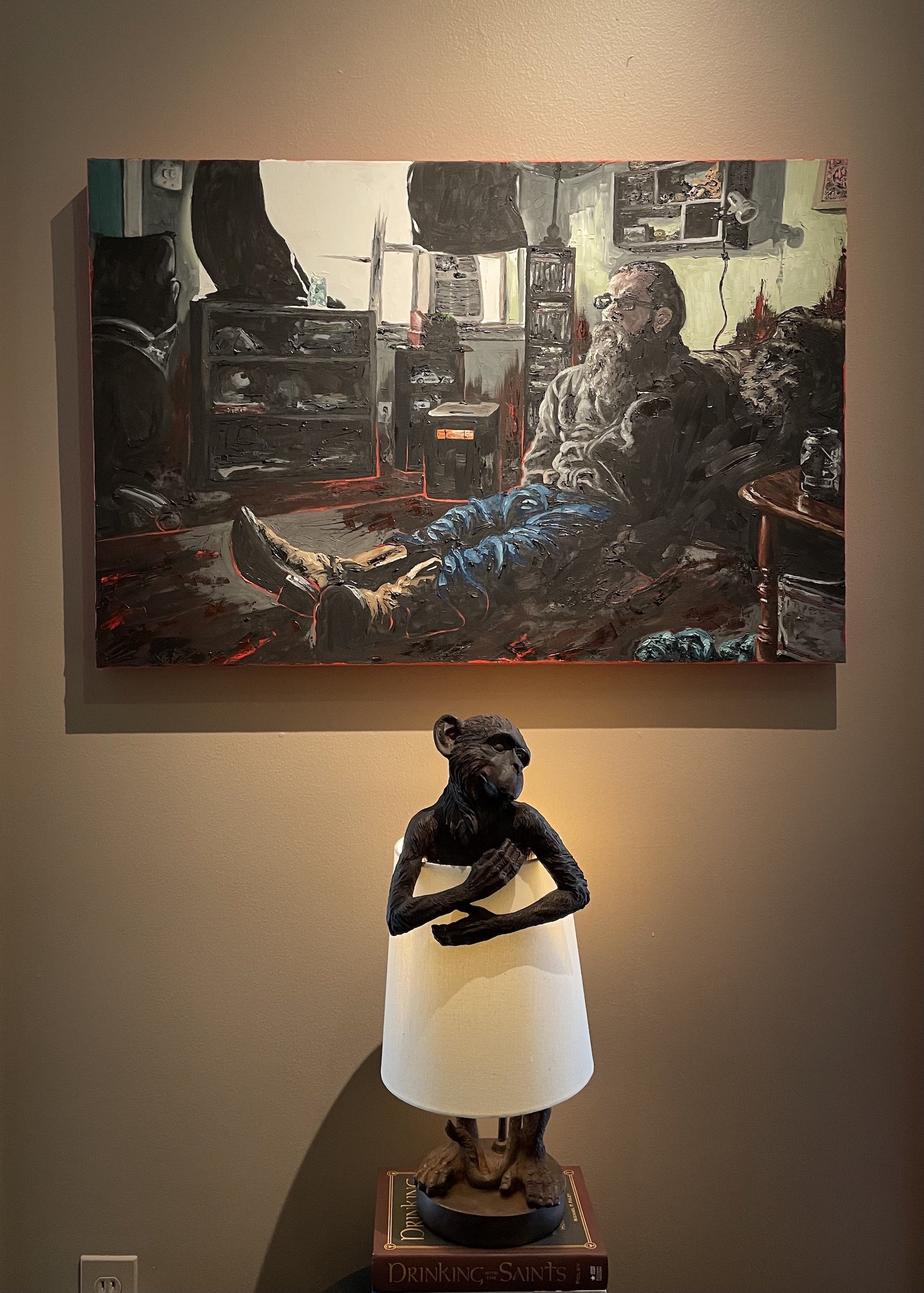
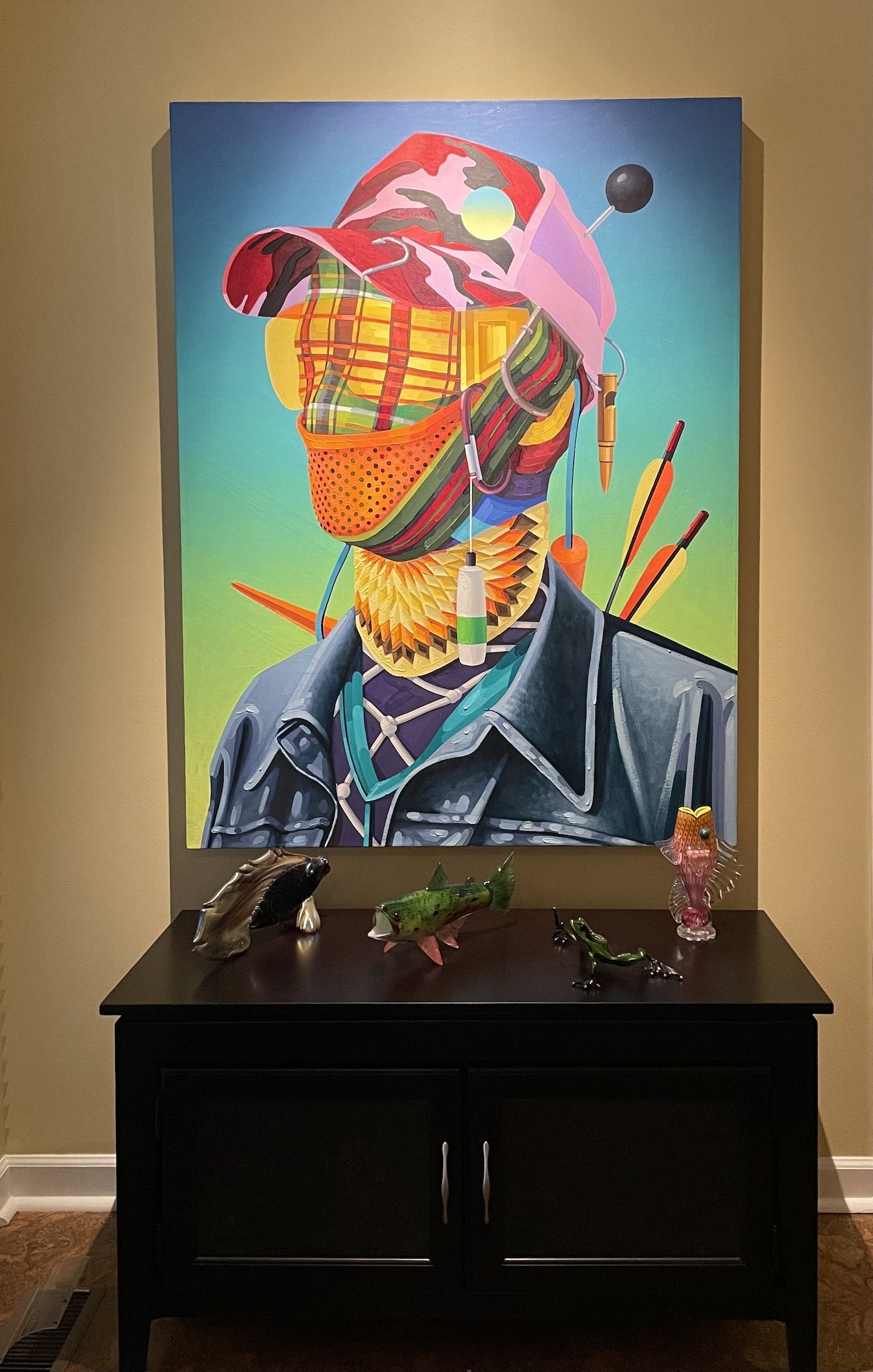
EW: When does admiring and appreciating shift into “We may want to buy this.” Are most of your decisions on the spot or do you sometimes reflect on the art and buy later.
JN: I don’t want to give the impression that our art purchases are impulsive, they are not. But they are not usually labored, drawn-out affairs. Truth be told, I actually don’t like shopping all that much.
PM: For me, I know almost instantly. Not impulsively, as Joe said, it is just that something can catch my eye very fast, and I instantly know it. And I probably take the lead on that more than Joe because I like to browse websites and go to galleries more than he does. But we never purchase a piece without the other seeing it first. I think the only times we have not purchased a piece right there on the spot was if we had to decide if we wanted to spend the money at that time, or if we had to think about where we would place it. As I mentioned, we are not wealthy art investors.
EW: How has your collection evolved over the years?
PM: As Joe mentioned we were very into abstracts when we started buying art together. Then we saw work by Sheila Cotton and realized we liked all styles. Our collection has works on canvas and paper, etchings and prints, abstracts to realism, and ceramics, glass, bronzes, and wood. We have tried to focus on Arkansas artists the last five years or so. We have 2D art from 35 Arkansas artists, and glass, pottery, wood, et cetera, from 12 Arkansas artists. There are so many talented Arkansas artists!
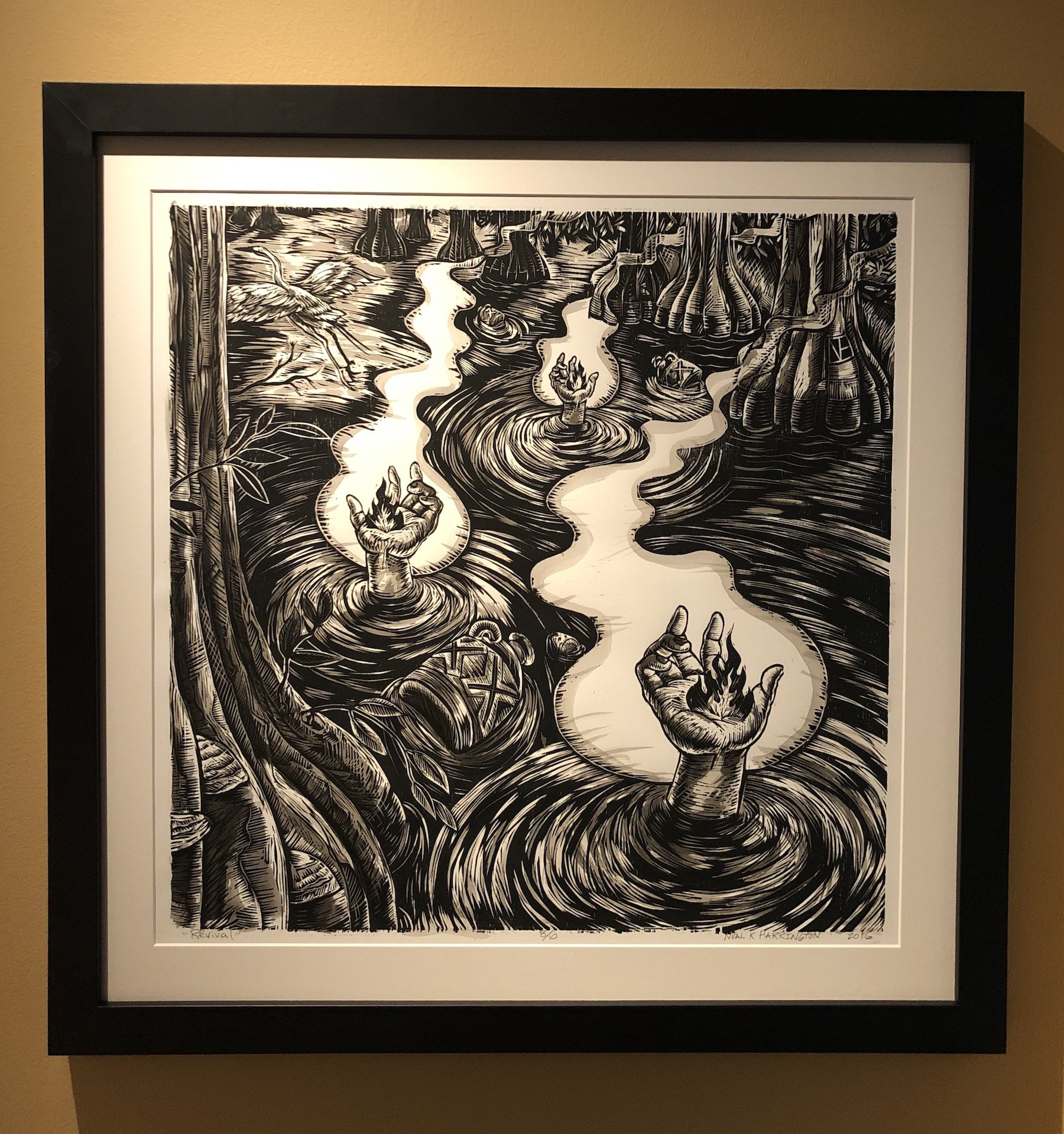
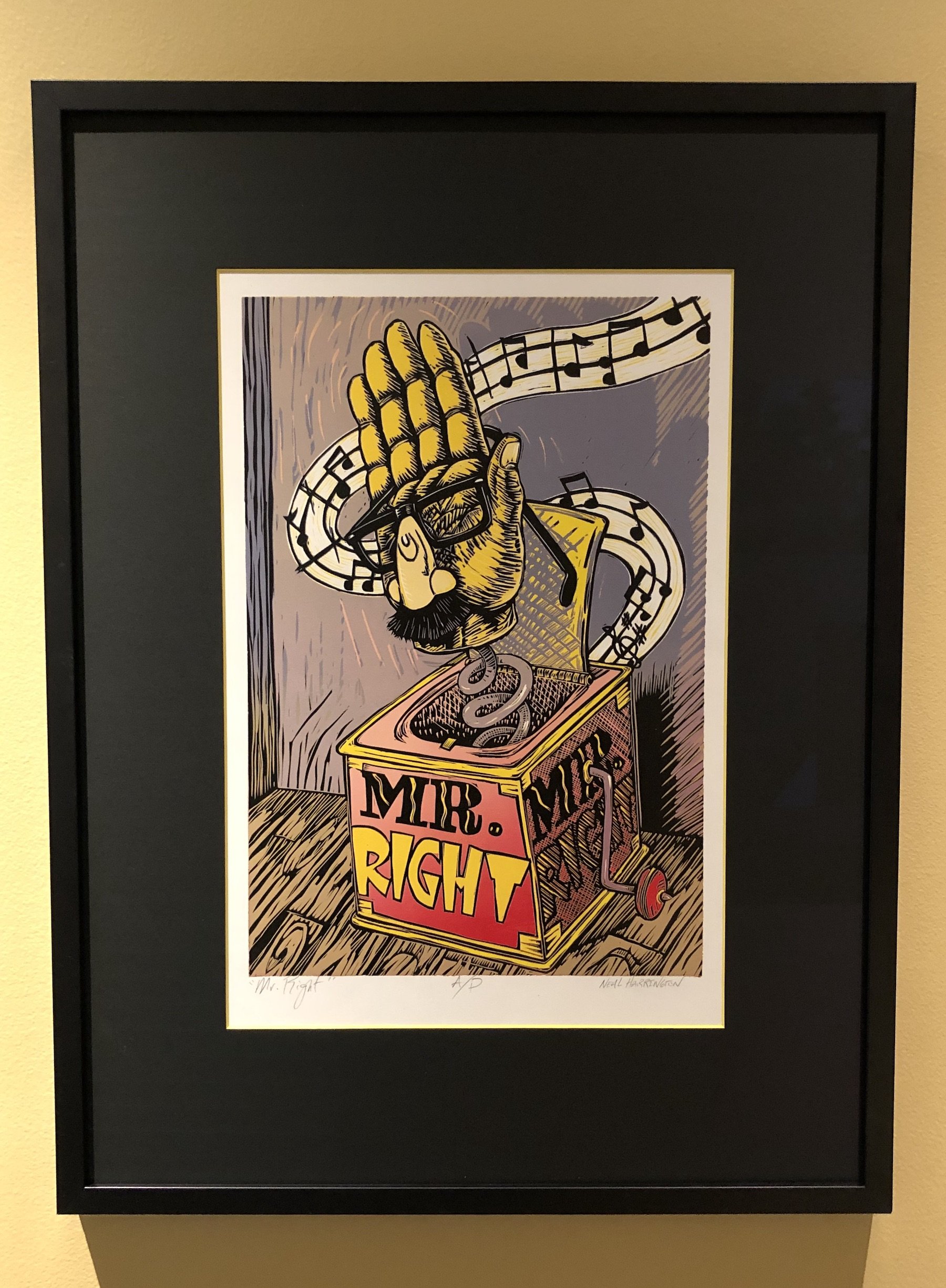
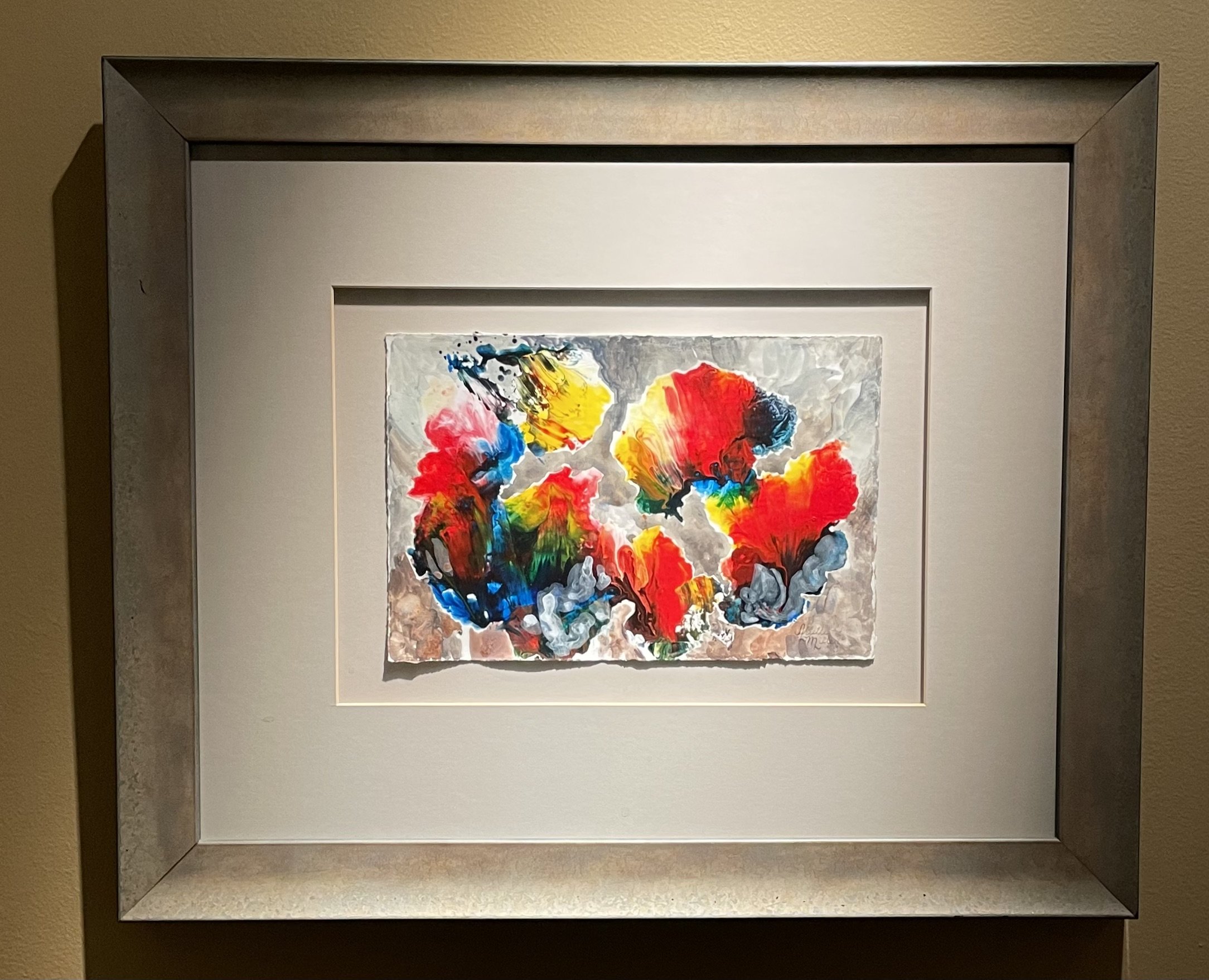
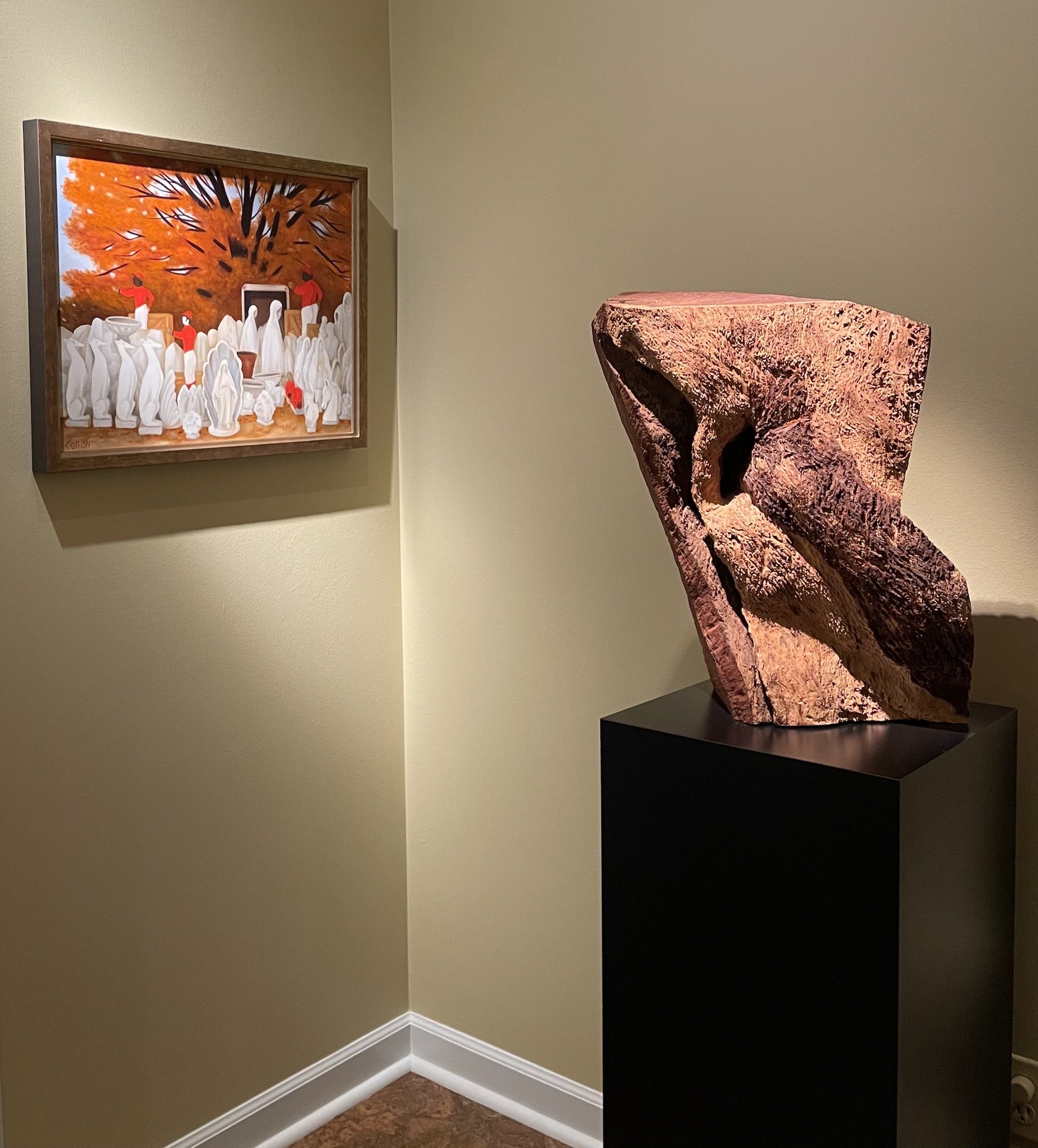
EW: Seeing your very impressive collection was quite a treat. Your spacious home is a perfect setting for art. It is exquisitely hung and lit, and it is fascinating how the works “talk” to each other. How do you decide where to hang a new work?
JN: Oh, we appreciate that coming from you especially. Thanks to the advice of our friend, designer and architect Wilson Stiles, all of the art is hung with the same focal point height (57.5” from the floor is our magic number). This technique is very subliminally pleasing to the eye, and we believe that this visual continuity contributes to our success at mixing so many different styles of paintings. Most often when a new piece comes home, we already have an idea where it will be placed and how it will be lit. Those decisions always factor into our purchases. We like and admire a lot of art that we won’t purchase for our home. Everything must coalesce into our style, whatever that is.
EW: Does meeting the artist influence your purchases and/or your appreciation of a piece?
PM/JN: Joe and I really like to meet the artist. But I am not sure it has an influence on whether we make the purchase. Looking back, I bet most of the time we meet the artist only after we have purchased their work. One thing I have learned from the blog is that learning more about an artist makes me appreciate the work more. I like learning about the artist as a person. We also like for them to see how their work is displayed in our home. Lately, that has most often been by sending photographs.
EW: How has the pandemic impacted you as a collector? Are you utilizing digital methods to preview art?
Tall Woven Basket with Open Collar #11, 20” x 13”, white oak, Leon Niehues
PM: Not going to galleries does reduce temptation. However, Joe would point out that the Arkansas Art Scene blog has opened my eyes to so much wonderful local art that I never knew was out there. Since all I see are images of an artist’s work, unless I have seen them in a gallery, I have learned to appreciate the digital format more than I did before. Although, I must say that not all work looks best in photographs. Much of it must still be seen in person to fully appreciate it, or to find out that it is not that special in person. A few months after I started the blog, I took an online course at Sotheby’s Institute of Art called The Art Of Collecting because I thought it might help with the interviews. This was during the pandemic, so the course instructor decided to give us more training on the do’s and don’ts of finding and buying art online. Our final assignment was to find a piece of art online that we “wanted to buy,” research the artist and the history of his/her work and then write a paper on why it was the right piece to add to our hypothetical collection. Well, when the assignment came out, I was just completing an interview with art appraiser Jennifer Carman, and she wanted to show her basket by Leon Niehues. I was blown away by its beauty and his skill. I had never heard of Leon, I am embarrassed to admit. Anyway, I decided to research him more and realized we needed one of his baskets. So, I wrote my final paper on Leon and Tall Woven Basket with Open Collar #11. My instructor from Sotheby’s was blown away by his work and I got an A+. She was even more excited when I told her we had acquired it. And I was able to interview Leon for the blog.
EW: What motivated you to start the blog?
PM: I was worried about what I would do after retiring. I loved galleries and artists and even thought about working part time in a gallery. Sheila Cotton suggested an art blog that would feature gallery openings and the occasional artist interview. I did some Googling and realized there was nothing like that out there – at least not for Arkansas artists and galleries. My plan was to start the blog in March 2020. Well, covid hit Arkansas right at that time so no gallery openings. I was scared to death of interviewing anyone, so I thought about interviewing artists whose work we own and know. Tessa Davidson was the first victim. But we both thought it turned out well and was fun. Since then, I have published one every week with the exception of a month off around Christmas. I do most of the writing of questions and layout. Joe helps with choosing artists and the final proofreading before publication.
“One thing I have learned from the blog is that learning more about an artist makes me appreciate the work more. I like learning about the artist as a person”
EW: What was the biggest challenge?
PM: The biggest challenge was learning Squarespace. But it turned out to be very easy and I highly recommend that platform for an artist’s website too. The second challenge was coming up with questions because, as I tell all the interviewees, I am NOT a professional. Actually, I think that kind of adds to the charm of the interview.
EW: Who was the most challenging interview? Has anyone turned you down?
PM: Honestly, there have been no really challenging interviews. I have been blown away by how appreciative the artists are and how many compliments and Thank You notes I have gotten from art collectors, gallery owners and other artists. I send out an introductory email requesting an interview, sometimes it happens that I just never hear back from the artist. I won’t call all of these turn downs. I have only been turned down directly two times. The blog is great free publicity for the artist with each interview getting 250 to 500 views. For an artist in the early stages of their career, it is an opportunity to present themselves and their work to a new audience. For a more established artist, it is an opportunity to tell their story, which they may never have done before. Everyone has enjoyed the experience, I believe.
EW: How do you find artists to interview and how have these interviews impacted your view of their art and art in general?
PM: I use gallery websites, university art department websites, Facebook, and Instagram to find potential artists to interview. For artists I am not familiar with, it is photos of their work that attracts me or not. I try to keep an open mind, but I am not influenced by trends or who might be the hottest artist at the moment. I have never been disappointed by an artist I have interviewed. One thing I have learned is that artists are never boring and always have interesting stories surrounding their lives and work.
EW: Are you considering changes in the blog’s direction or content?
PM: I can’t even think about not doing interviews now, even after 100. There are so many artists left to present and I am discovering more every day. What won’t change is that I only interview Arkansas artists whose work I like and who I want to learn more about.
EW: Thank you Phil and Joe for the opportunity to get an insight on your vision as art lovers and as collectors. It was a joy to see your fascinating and diverse collection and to have you share how art and artists have enriched your lives. The Arkansas Art Scene Blog is a natural outgrowth of that love of art and artists and is an invaluable resource. It seems only fitting that you two are the 100th interview. I look forward to the next 100! And, just for the record, you both are artists … culinary artists!
